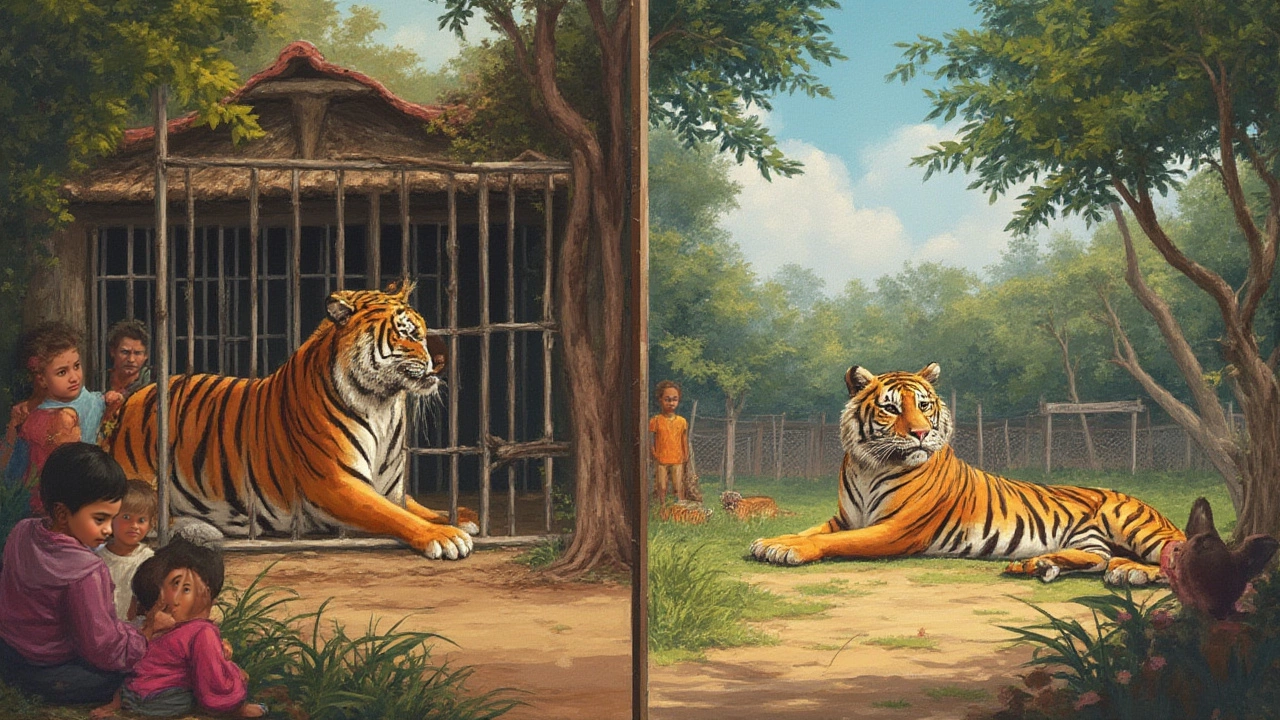Picture this: you’re staring at a silverback gorilla pressed against thick glass at the city zoo, a child squealing beside you. He looks bored, strangely human in his slouch, his mind likely miles from the concrete cave he calls home. Now, imagine watching a troop of rescued chimps leaping through leaves in a sprawling woodland sanctuary. The contrast is striking; it sticks with you. The choice between a zoo or a sanctuary is more than just picking where to spend your Sunday—it’s a question that cuts into the heart of animal ethics, conservation, and even how we see our own place in the world.
How Zoos and Sanctuaries Work: Not Just Different Names
Zoos have been part of most of our childhoods, and honestly, a day at the zoo was a staple for me growing up in Bristol. But a lot has changed since those first menageries popped up in Europe centuries ago, where wild animals were treated like living trophies. Now, most modern zoos say their focus is on conservation, education, and research. But the picture isn’t always that neat.
At their core, zoos are usually designed for the public: they’re businesses that rely on ticket sales, marketing, and special events. That means animals are often chosen for their ability to draw a crowd, rather than their conservation need. Think lions, elephants, and penguins over more obscure, less “photogenic” species. Exhibits are laid out for people, sometimes at the cost of what’s best for the animal—tight enclosures, noisy crowds, and sometimes unnatural groupings.
Then you’ve got sanctuaries. These are less about business, more about giving a permanent home to animals who can’t survive in the wild—rescued from circuses, illegal pet trades, or people’s misguided attempts at exotic pets. They don’t breed or sell animals, and the public isn’t always welcome. Instead, their badges usually read “rescued, not displayed.”
An example? The Born Free Foundation’s Shamwari Big Cat Sanctuary in South Africa gives rescued lions and leopards room to roam, often transforming animals with a history of trauma. And up in Scotland, the Highland Wildlife Park doesn’t just recreate the animals’ native habitats almost down to the last bush, but also supports rewilding projects locally.
Still, real life isn’t black and white. Some European zoos now resemble sanctuaries, and some sanctuaries open doors for paying guests to fund animal care. What matters is intention: are they for entertainment, or animal welfare?
Animal Welfare: Does One Really Win?
Here’s where it gets heated. If you care about animal welfare, the devil’s in the details. The most obvious difference is space. In zoos, even the best ones, animals live in spaces much smaller than what they’d call home in the wild. A 2014 study by Captive Animal Protection Society found that tigers in European zoos had, on average, just 0.07% of the space they’d naturally cover in the wild. Now imagine a tiger whose territory would stretch out 100 square kilometres outside, but is crammed into a few hundred square metres. That’s a mental strain that often leads to pacing, self-harm, or the infamous “zoochosis”—those repetitive behaviours you sometimes see pacing up and down enclosure fronts.
Sanctuaries aren’t perfect, but their focus is different. They aim to reduce stress and mimic the animal’s natural environment as closely as possible. Most make sure there’s little to no direct interaction with visitors. That gives rescued animals the space—and privacy—they desperately need to heal.
It’s not just about space. The food, social groups, stimulation, and medical care all matter. Some top-notch zoos invest millions in enrichment toys, complex feeding methods, and even hydrotherapy. Yet, no elephant ever chose to live on concrete, and no polar bear feels at home in Bristol no matter how deep the so-called ‘Arctic’ pool.
Sanctuaries don’t always have mega budgets, but what they lack in flash, they often make up in individual care. A rescued orangutan at Borneo Orangutan Survival Foundation’s sanctuary gets more say in her routine than her zoo cousin. She might never see a crowd again—a blessing, rather than a curse.
Of course, there are bad sanctuaries. Some are little more than “hands-on” petting zoos or tourist traps in disguise. Checking for accreditation matters; look for links to respected groups like the Global Federation of Animal Sanctuaries (GFAS) or the British and Irish Association of Zoos and Aquariums (BIAZA).
| Aspect | Modern Zoo | Accredited Sanctuary |
|---|---|---|
| Space per animal | Limited (often <1% wild range) | Usually larger, more natural |
| Animal sourcing | Bred in captivity or traded | Rescued, not bred |
| Public access | Designed for visitors | Restricted/minimal |
| Breeding programs | Common | Rare or never |
| Main focus | Education/conservation | Animal welfare/rehab |

Conservation and Education: Who’s Making Real Change?
If you listen to your average zoo director, the mission these days is all about “saving species.” Europe’s EAZA members alone reportedly spend over £20 million a year on global conservation programs. And yes, there are wins: the Arabian oryx went extinct in the wild in 1972 but was reintroduced thanks to zoo breeding programs. Pere David’s deer—a Chinese species totally extinct outside captivity—survive because of zoos.
The best modern zoos invest in research and education too. Bristol Zoo’s studies have supported endangered amphibian reintroductions, and Chester Zoo even launched a conservation training centre to upskill local rangers.
But there’s a catch. Not every animal on display is endangered. Earlier this year, a Guardian report found that up to 70% of animals in Europe’s largest zoos don’t fall on any urgent conservation list; meaning lots are still kept purely for public entertainment. And regardless of the PR speak, only a tiny fraction of zoo animals ever enter rewilding projects.
Sanctuaries don’t usually breed or release animals, because their residents—think abused lions or retired circus elephants—couldn’t hack wild life. Instead, they often fight the battle from another side: inspiration and activism. Take the story of Christian the Lion, who was rescued and later put into a Kenyan sanctuary. The viral video of his wild reunion with former carers sparked massive donations for animal welfare groups almost overnight. Sanctuaries also fuel grassroots education, lobbying against the exotic pet trade or illegal wildlife trafficking.
Want to get involved? Ask local sanctuaries about their outreach. Some invite volunteers to help with daily care or conservation projects. Others run school workshops—not flashy gift shops, but real talks about animal struggles and successes. It might be less glamorous, but you won’t leave with any fairy tale notions.
“The greatness of a nation and its moral progress can be judged by the way its animals are treated.” — Mahatma Gandhi
Ethics, Controversy, and Public Opinion: Changing Minds
The ethics of keeping wild animals in captivity fires up fierce debate. Just look at the worldwide fallout after Netflix’s ‘Tiger King’—which wasn’t exactly an advert for good sanctuaries—or the uproar when London Zoo put on “late-night discos” close to tigers. On the other hand, sanctuaries sometimes get hit with criticism for not releasing more animals or for high running costs.
Your own ethical line might land somewhere in the grey area. Some believe that zoos, with strict rules and genuine care, can be a force for good—especially for species teetering on extinction. Others say the best place for any animal is the wild, and any captive environment, no matter how plush, falls short.
Public opinion is shifting, though. A 2022 poll in the UK showed that 57% of adults would rather visit an animal sanctuary than a traditional zoo. The rise of #EmptyTheCages on social media shows growing discomfort with animal captivity for entertainment.
If you want to vote with your wallet, pay attention to where your pound goes. Does your visit help conservation projects, or is it just funding another “zoo selfie” booth? Are you seeing rescue stories, or just clever marketing wrapped in animal print?
Don’t fall for greenwashing, either. That “sanctuary” where you can pet tiger cubs? That’s a red flag. Reputable places avoid live animal handling, don’t breed for profit, and put animal needs above visitor quotas.

Tips for Ethical Animal Encounters (Without the Guilt)
No one wants to leave an animal attraction feeling tricked. So how do you make the smart, kind choice?
- Research every place before you go. Genuine sanctuaries usually show rescue stories and animal backgrounds. Flashy shows or baby animal “meet and greets” are warning signs.
- Look for accreditation. Both the Global Federation of Animal Sanctuaries (GFAS) and British & Irish Association of Zoos and Aquariums (BIAZA) have public lists. Checking these is way cooler than blindly trusting glossy ads.
- Ask staff tough questions. Where do the animals come from? What happens to surplus animals? Real sanctuaries will be happy to chat; dodgy places dodge everything.
- Support those with clear, transparent financials. Sanctuaries need funds, but everything should funnel back to animal care, not owner profits.
- Choose experiences that put animal welfare first. Silent observation is better than selfie sessions. If animals approach you out of curiosity, even better—but don’t force the moment.
- Volunteer or sponsor, don’t shop. Rather than buying plastic souvenirs, donate or join local campaigns supporting wildlife rescue.
- Remember, wild spaces are the real goal. The best-case scenario doesn’t involve cages at all. Support rewilding charities, nature reserves, and eco-travel leaders where animals live wild—not in captivity.
Human curiosity about the wild isn’t going away any time soon. We all want that close-up moment with a cheetah or a bear. But as our understanding grows, it’s clear those animals deserve a fair deal—and it’s up to us to demand it, wherever we choose to visit.
